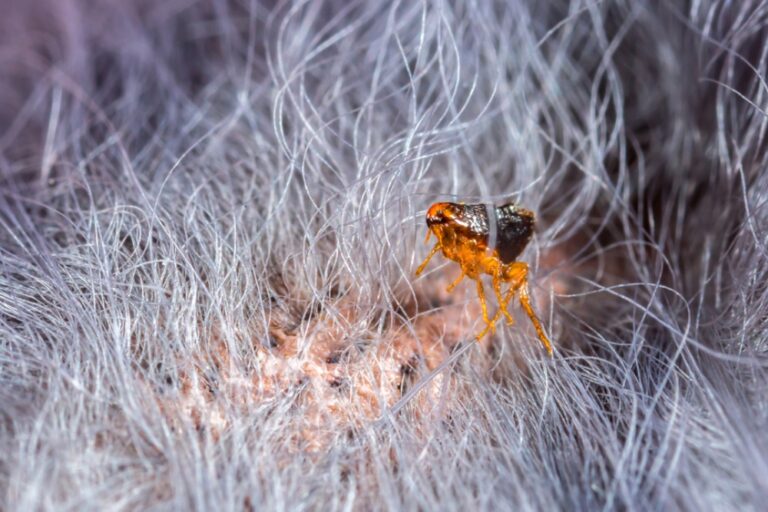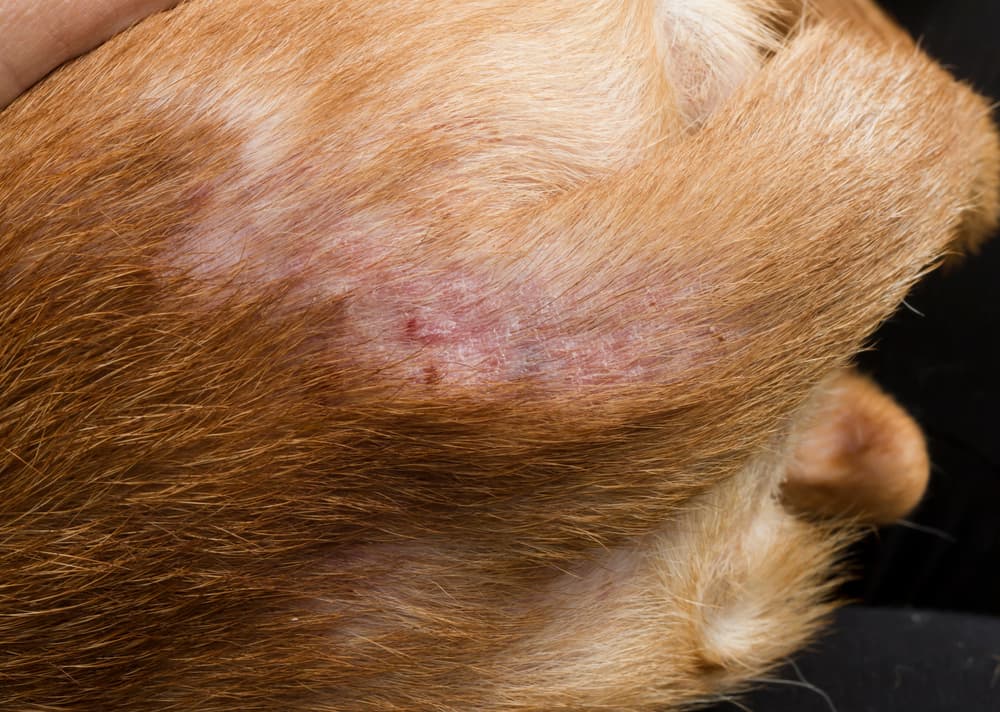Flea Bites on Dogs: What Do They Look Like?

Flea bites are the top cause of the itchiness and scratching associated with skin allergies in dogs. In some cases, flea bites on dogs can escalate into serious (or even fatal) health problems. Given that fleas can cause so much damage, learning to identify them and their bites is important.
Locating dog flea bites (and the actual fleas themselves) isn’t always straightforward, which is why we asked veterinarians to help. We’ve also provided tips on treating flea bites and preventing infestations, so your pup doesn’t have to suffer needlessly. If you suspect your dog has fleas or exhibits any unusual symptoms, contact your veterinarian.
What Do Flea Bites Look Like on Dogs?

Flea bites on dogs generally look like miniature raised red dots. They’re sometimes mistaken for bed bug bites and mosquito bites, though flea bites are usually a bit smaller. An allergic reaction – marked by excessive scratching and chewing – can cause the bite to become inflamed.
Even if you know what dog flea bites look like, they’re not always the easiest thing to locate, especially on pups with denser fur. “Often flea bites go unnoticed on the skin unless a severe infestation is present,” says Dr. Audrey Weaver, a partner doctor who works at Heart + Paw in their Glen Mills, Pennsylvania location.
It’s usually easier to detect the presence of flea dirt, dark brown particles (made of flea feces) that resemble coffee grounds, adds Dr. Jerry Klein, chief veterinary officer for the American Kennel Club, based in New York City. Flea dirt is “seen when the hair of an infected animal is parted, often near the base of the tail, near the skull, or on the groin or inside the hind limbs.”
Types of Fleas on Dogs
Of the estimated 2,500 species of fleas worldwide, only a few impact North American dogs. Veterinarians say that most dog flea bites, regardless of the species, look similar.
The following types of fleas are some to watch for in the United States, with the cat flea being the most common and widespread by far.
Cat Flea (Ctenocephalides felis)
If your veterinarian diagnoses your dog with flea bites, it likely originated from the cat flea, the most prevalent flea species in the United States. The cat flea is a host for diseases that can also be transmitted to humans. These include Rickettsia typhi, the bacteria that causes typhus, and the Bartonella henselae bacteria, which is responsible for spreading the bartonella infection.
Dog Flea (Ctenocephalides canis)
The dog flea looks a lot like the cat flea, except that it’s not as widespread. This doesn’t mean it can’t cause harm, though, as the dog flea serves as a host to parasitic tapeworms.
Poultry Sticktight Flea (Echidnophaga gallinacea)
The poultry sticktight flea is primarily a risk for dogs who’ve had contact with infested backyard poultry. While this species doesn’t transmit disease, infestation can lead to a secondary infection.
Oriental Rat Flea (Xenopsylla cheopis)
Though the Oriental rat flea may make its living by feasting on rodents, it’ll attach itself to dogs if needed. This type of flea carries Yersinia pestis, the bacteria responsible for the plague.
Symptoms of Flea Bites on Dogs

Fleas bites on dogs can cause a number of agonizing symptoms like itchiness, redness, and scratching, not to mention infections and medical issues. Because some of these issues can be serious, it’s important to contact your veterinarian right away if your dog is displaying any unusual symptoms.
Itchiness and Scratching
“Some pets may have a flea allergy, which means that when the flea bites the pet, the saliva of the flea triggers an allergic reaction in the pet’s body,” says Dr. Weaver. One of the effects of this, she says, is itchiness, which veterinarians refer to as pruritus. A flea bite allergy is, in fact, the leading cause of itchiness and scratching in dogs.
Hives, Wounds, and Hair Loss
When your pup is allergic, flea bites can also result in symptoms like hives, swelling, severe redness, and significant hair loss, says Dr. Weaver. Excessive scratching, licking, and chewing can exacerbate this.
Red Bumps
Flea bites on a dog appear as tiny, raised red spots. They can become inflamed from excessive scratching and chewing.
Flea Dirt
Where there’s fleas and dog flea bites, there’s bound to be flea dirt, which is the combination of flea fecal matter and the host’s blood. In fact, it’s actually easier to locate flea dirt than actual flea bites.
Flea-Borne Infection
Flea bites rarely result in lasting harm, says Dr. Klein. “However, flea bites can be dangerous because they may spread diseases that can be serious and, in some cases, even fatal.”
One of these diseases is the bartonella infection, which can cause fever, nosebleeds, and heart problems in dogs. Pups who ingest infected fleas risk acquiring tapeworms, with symptoms that include vomiting and diarrhea.
Anemia
Fleas are voracious parasites, so an infestation can cause the type of blood loss that leads to anemia, which Dr. Klein says is “extremely dangerous in very small or young puppies.” Symptoms of anemia include pale gums, increased fatigue, and appetite loss.
How to Treat Flea Bites on Dogs
If you suspect your dog has fleas, start by contacting your veterinarian for a proper diagnosis and treatment. The actual flea bites on dogs rarely require treatment, says Dr. Klein, “unless they become infected or if the animal is experiencing an allergic reaction called flea bite dermatitis.”
Veterinarians will typically start by treating the flea outbreak itself, crafting a plan that incorporates killing adult fleas on the dog, ridding the home environment of fleas, and preventing future infestations.
They will generally prescribe medication in the form of prescription veterinary insecticides, most of which offer both prevention and treatment benefits. These medications are available in a variety of formulations, including:
- Fluralaner (found in Bravecto products)
- Fipronil (Frontline)
- Afoxolaner (Nexgard)
- Lotilaner (Credelio)
- Sarolaner (Simparica)
- Imidacloprid (Advantage)
- Sarolaner (Simparico)
Prescription flea products should work quickly and effectively. “Most prescription flea products will begin killing fleas in one to four hours,” explains Dr. Weaver. “The itching and redness typically begins resolving as the flea burden reduces. For pets that have wounds caused by the pet biting/chewing at the skin, healing time varies for each pet but can range from 5 to 21 days, sometimes longer depending on severity.”
If your pet is experiencing any symptoms and conditions associated with flea bites, like anemia or flea allergy dermatitis, your veterinarian will also address them in the process. For example, flea allergy dermatitis is typically treated with antihistamines and antibiotics, according to Dr. Klein.
The home must also be treated and cleaned, says Dr. Weaver. “This includes bedding, carpet or rugs, and mattress if the pet sleeps in the bed with the pet parent.”
Home Remedies for Flea Bites on Dogs
There really aren’t any reliable home remedies for flea bites on dogs, veterinarians say. “All medical treatment for parasitic conditions to an animal should be determined by a veterinarian,” recommends Dr. Klein.
Some OTC treatments can actually be hazardous to your dog as well. With topical ointments, for example, “the pet may lick the area and ingest the ointment which has the potential of being toxic,” Dr. Klein adds.
Bathing your dog dog with a soothing, medicated shampoo, however, is one way to provide temporary relief from fleas, says Dr. Weaver. It’s important to choose a shampoo specifically formulated for dogs and be aware that some can interfere with topical tick and flea medicines.
How to Prevent Flea Bites on Dogs

Flea and flea bite prevention are important to the health of all dogs, regardless of geographic location. Though fleas are more prevalent in warm and humid regions like the Southeast and Southern Plains, they can be found anywhere in the United States, even in cooler temperatures.
It’s much easier to prevent flea bites and infestations than it is to have to treat your dog and fumigate an entire home. Fortunately, managing fleas is straightforward. Veterinarians are always available to guide you in choosing the best flea prevention and treatment measures for your dog, and they agree that the easiest and most effective way to avoid flea infestations is with year-round flea medicine.
There are numerous flea preventive formulations available that accommodate busy lifestyles. These include topicals, chews (given every one to three months), and collars. Many of these also offer protection against ticks, roundworms, hookworms, or other pests.
Other Practices to Help Prevent Flea Bites on Dogs
Check your dog for fleas. Regularly sift through your dog’s fur with a flea comb to search for fleas, flea dirt, or flea eggs. Another option is to hire a professional pet groomer to do it.
Practice good housekeeping. Vacuum rugs and carpets at least every other day. And since flea eggs are adept at hiding in cracks and nooks, make it a habit to mop and sweep the floors. It’s also essential to clean bedding (both yours and your dog’s) with soap and water to help control flea infestations.
Don’t forget about the backyard. If your outside area attracts wild animals, consider adding fencing or placing netting on plants as a deterrence.
Bathe your dog. Veterinarians say giving your dog regular baths can help. An added benefit is that you get to spend quality bonding time with your pup.









